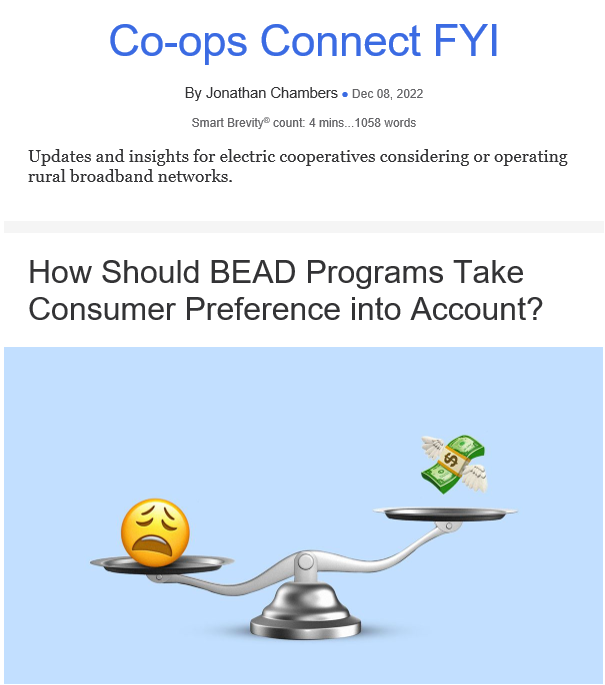How Should BEAD Programs Take Consumer Preference into Account?
December 8, 2022
BEAD is a universal service program, supplementing dozens of state and federal rural, high-cost and low-income programs.
- BEAD sits in the vein of programs meant to address the market failure of broadband service availability in rural, high-cost areas.
- There are other parts of BEAD meant to address other traditional universal service objectives, including service affordability to low-income households.
Consumer preference is an unusual concept for rural, high-cost programs.
- For over 100 years, the construct of state and federal rural universal service programs has been an exchange of service availability for monopoly protection and industry subsidies.
- Government-conferred monopolies and subsidies were accompanied by requirements that a service provider would serve everyone in a geographic area, so-called Carrier of Last Resort obligations.
The big picture:
Consumer preference has not been an element of rural universal service programs.
Traditionally, a consumer had no choice but to take what the government and incumbent telephone company agreed to provide.
History in Brief
For much of the country for much of the history of telecommunications, “choice” meant AT&T and a black rotary phone.
A brief timeline of universal service subsidies:
- AT&T was broken up in 1982 via a court decree, referred to as the Modified Final Judgment (MFJ).
- Yes, but: The break-up of the universal service subsidy regime has been slower and taken much longer.
- The change was set in motion with the adoption of the 1996 Telecommunications Act.
- In the late 1990s, the FCC began allowing rural, high-cost subsidies for Competitive Eligible Telecommunications Carriers, which were principally mobile phone companies.
- In 2011, the FCC laid the groundwork for broadband subsidies and allocated $4.5 billion in annual subsidies exclusively to the nation’s telephone companies.
- No competition continued to mean no choice or consumer preference in rural areas.
- In 2018 and then in 2020, the FCC placed about half of those subsidies on a competitive track, through the Connect America Fund and Rural Digital Opportunity Fund auctions.
- Today, the nation’s small telephone companies continue to cling tobthe other half of FCC rural subsidies.
BEAD Changes Everything
How?
1. BEAD changes the locus of decision making to the states.
2. BEAD will scramble the nation’s rural broadband monopolies.
Then what?
1. Either: States will cast rural areas into new decades-long monopolies.
2. Or: It will give rise to consumer preference.
I’m betting on the land grab for new monopolies.
Why it matters: Things could get even worse in parts of rural America.
You hear a lot of crap about the need for technological neutrality in the
BEAD program — usually by purveyors of inferior technologies.
One thing I’m sure of after three decades in the industry:
Consumers don’t give a damn about technological neutrality.
Consumers want the best technology.
Consumer preference is usually revealed in the marketplace.
- Consumer preference kicked Nokia candy bar phones to the curb in favor of iPhones.
- Consumer preference kicked DSL to the curb in favor of cablenbroadband and fiber optic networks.
- Consumer preference kicks a lot of goods and services to the curb. But not in government programs, which don’t take consumer preference into account.
- Consumer preference for broadband has overwhelmingly been revealed to be cable and fiber over DSL, fixed wireless and satellite. Yet, the FCC spent a decade and over $45 billion primarily on DSL and fixed wireless.
- The bottom line: Why would you think the $42.45 billion BEAD program will be spent differently?
The Example of Fixed Wireless
When I was at the FCC, we ran a regression analysis on the consumer preference of fixed wireless and satellite service in areas where there was also cable or fiber.
- It shouldn’t surprise anyone that less than one percent of consumers preferred fixed wireless or satellite to cable or fiber optic services.
- Fixed wireless and satellite report large coverage areas and miniscule consumer adoption.
By the numbers:
- Starry recently reported its penetration had risen to 1.5%. Starry recently turned down its RDOF award, claiming rising cost, which is understandable at a less than 2% take rate.
- Rise Broadband, the nation’s largest fixed wireless provider, has a penetration of 1%.
- NextLink, among the largest recipients of federal funds in the CAF and RDOF auctions, fares no better.
The T-Mobile example:
Just this past week, T-Mobile issued a report on fixed wireless.
The mobile industry has been providing fixed wireless access for decades, but T-Mobile believes this time it’s different.
By the numbers:
- T-Mobile reported to the FCC this summer that it makes fixed wireless available to over 90 million households.
- Doing the math, 2 million subscribers puts T-Mobile at 2%.
- But T-Mobile claims most of its growth is from 5G fixed wireless access, which reaches 40 million households.
- T-Mobile says half its customers switch from cable.
- T-Mobile attributes part of its success to being able to convince consumers they don’t need all the speed they think they need. Time will tell.
The bottom line:
Cable and fiber still serve over 95% of the broadband market in urban and suburban America.
- If consumer preference is not taken into account in BEAD, the program will spend public money to create new monopolies for types of service rejected by 95% of the public.
The Final Word
What does this all say about consumer preference in rural universal service programs?
The FCC has data that shows what consumers choose when they have choice.
- To spend public money on technologies that are chosen by only 1 to 2% of the population is a terrible way to spend the public’s money.
- To do so in the name of technological neutrality is a display of technological ignorance.
For decades, while in government and industry, I’ve written about consumer choice as an element of rural universal service programs.
I’ll keep returning to it. Consumer preference can be and should be part of BEAD.

